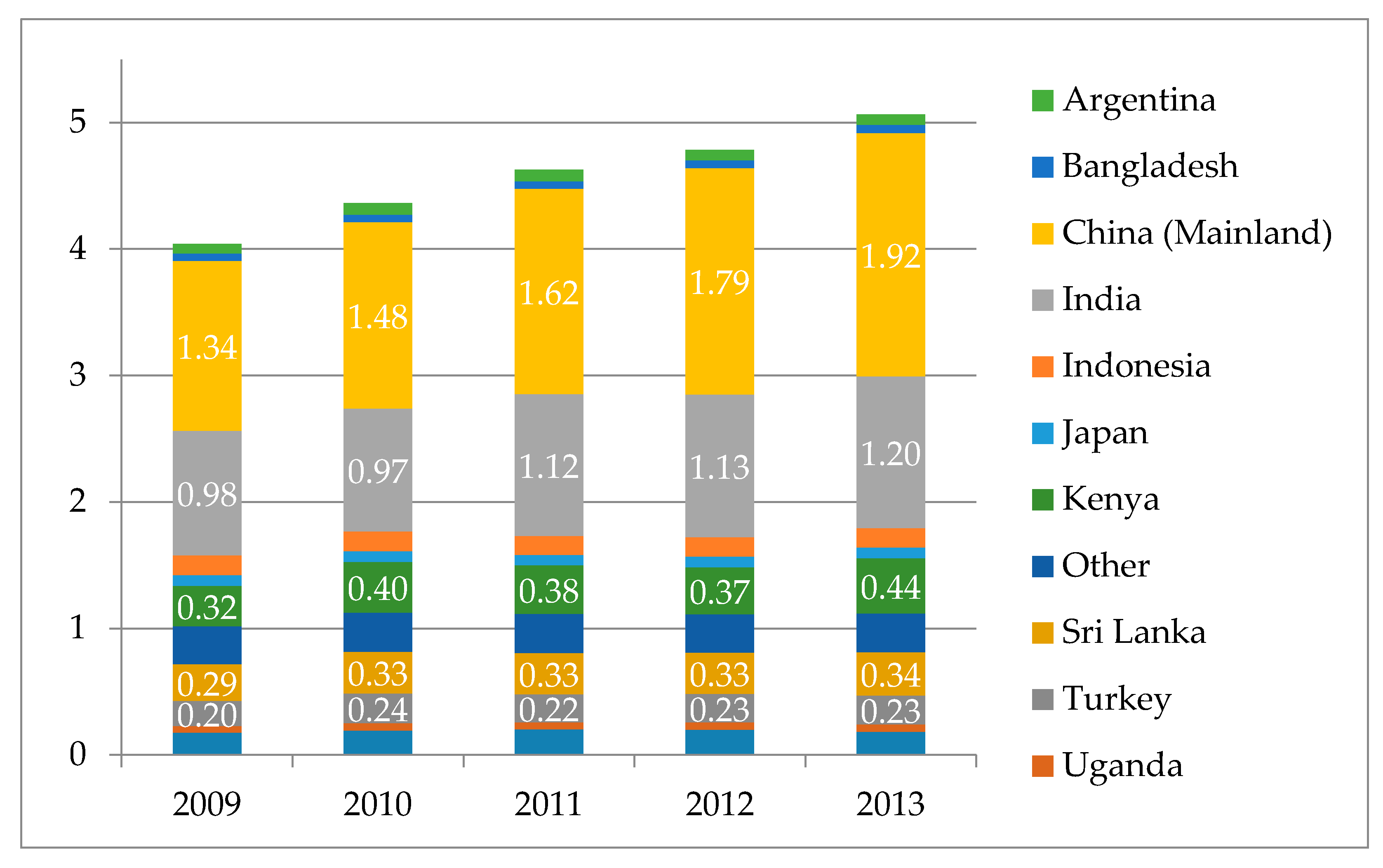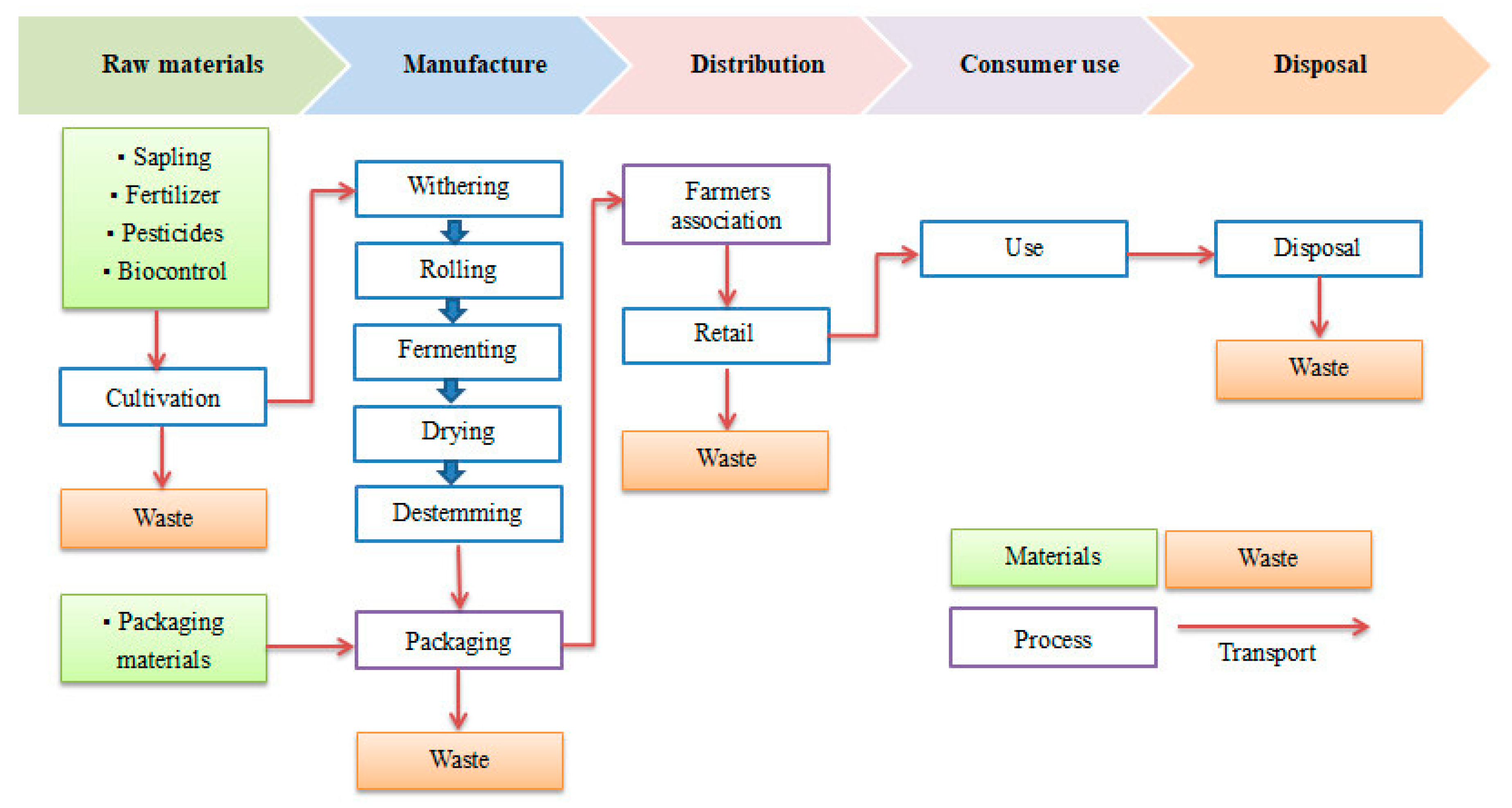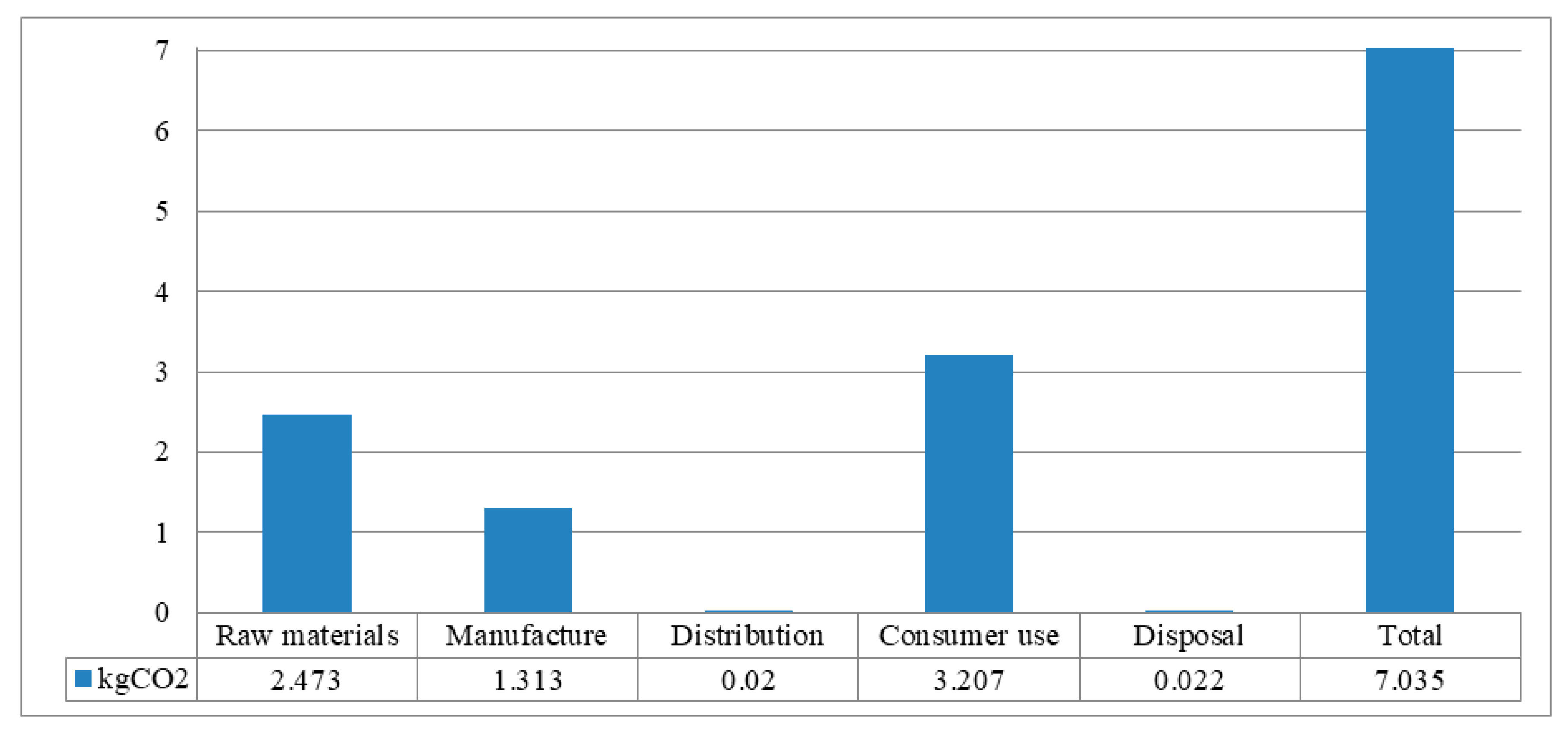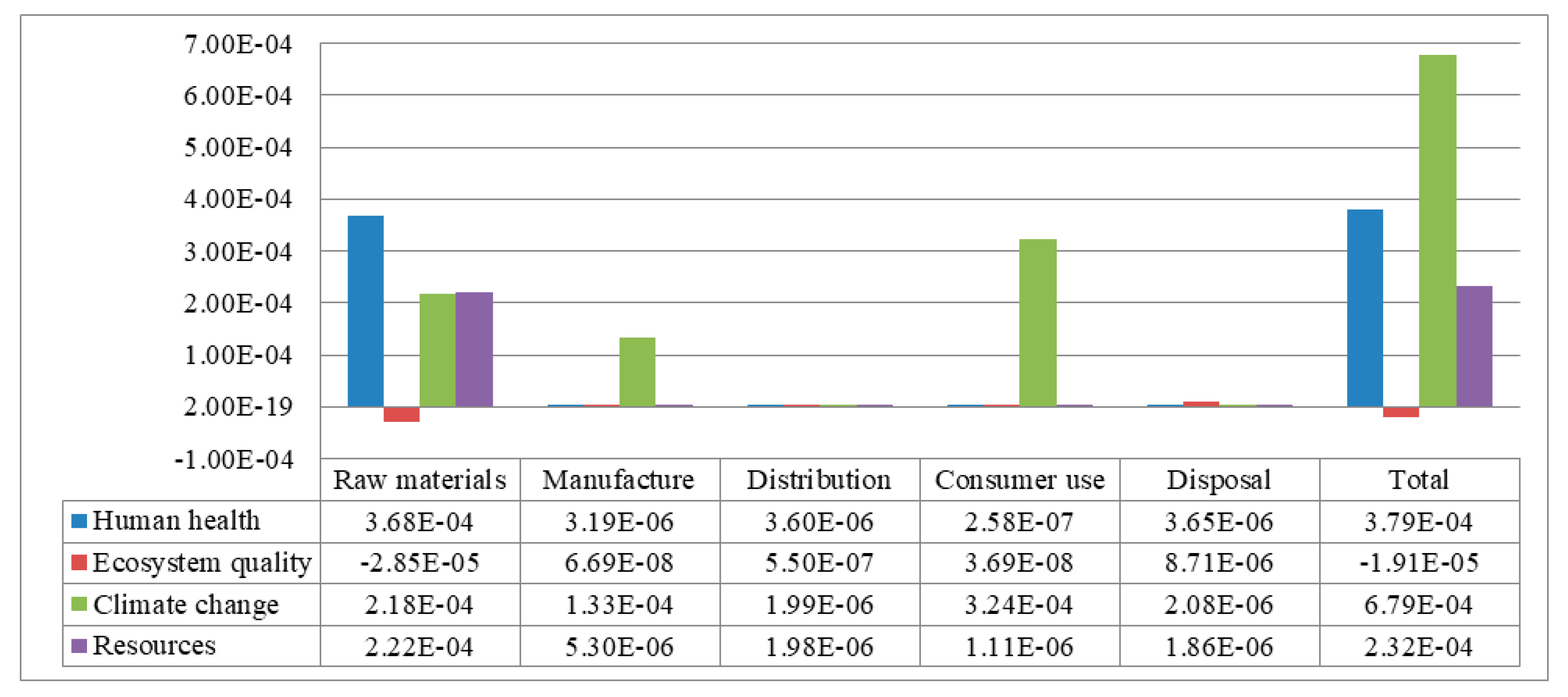Environmental Impact and Carbon Footprint Assessment of Taiwanese Agricultural Products: A Case Study on Taiwanese Dongshan Tea
Abstract
1. Introduction
- (1)
- Comprehend the environmental impact from the carbon emission and life cycle of Dongshan tea via LCA;
- (2)
- Determine the carbon emission sources from Dongshan tea from cradle to grave according to the results of LCA;
- (3)
- Assess the study results and propose proper countermeasures for reducing environmental impact and carbon emission.
2. Materials and Methods
2.1. Study Scope and Goal
2.2. Life Cycle Inventory (LCI) Analysis and Limited
2.3. Carbon Footprint Analysis
2.4. Life Cycle Impact Assessment (LCIA)
3. Results and Discussion
3.1. Carbon Footprint Analysis Results
3.2. LCIA Results
4. Conclusions and Perspectives
Author Contributions
Funding
Acknowledgments
Conflicts of Interest
References
- Edenhofer, O.; Pichs-Madruga, R.; Sokona, Y.; Farahani, E.; Kadner, S.; Kadner, K.; Seyboth, A.; Adler, I.; Baum, S.; Myhre, G.; et al. Climate Change 2014: Mitigation of Climate Change; Working Group III Contribution to the IPCC Fifth Assessment Report; Cambridge University Press: Cambridge, UK, 2015. [Google Scholar]
- Food and Agriculture Organization of the United Nations (FAO). Regional Strategy for Sustainable Hybrid Rice Development in Asia; Food and Agriculture Organization of the United Nations Regional Office for Asia and the Pacific: Bangkok, Thailand, 2014. [Google Scholar]
- Irani, Z.; Sharif, A.M. Sustainable food security futures: Perspectives on food waste and information across the food supply chain. J. Enterp. Inf. Manag. 2016, 29, 171–178. [Google Scholar] [CrossRef]
- Runhaar, H. Tools for integrating environmental objectives into policy and practice: What works where? Environ. Impact Assess. Rev. 2016, 59, 1–9. [Google Scholar] [CrossRef]
- Godfray, H.C.J.; Beddington, J.R.; Crute, I.R.; Haddad, L.; Lawrence, D.; Muir, J.F.; Pretty, J.; Robinson, S.; Thomas, S.M.; Toulmin, C. Food security: The challenge of feeding 9 billion people. Science 2010, 327, 812–818. [Google Scholar] [CrossRef] [PubMed]
- Meyfroidt, P. Trade-offs between environment and livelihoods: Bridging the global land use and food security discussions. Glob. Food Secur. 2018, 16, 9–16. [Google Scholar] [CrossRef]
- Lobell, D.B.; Schlenker, W.; Costa-Roberts, J. Climate trends and global crop production since 1980. Science 2011, 333, 616–620. [Google Scholar] [CrossRef] [PubMed]
- Kangalawe, R.Y.M.; Mungongo, C.G.; Mwakaje, A.G.; Kalumanga, E.; Yanda, P.Z. Climate change and variability impacts on agricultural production and livelihood systems in Western Tanzania. Clim. Dev. 2017, 9, 202–216. [Google Scholar] [CrossRef]
- Sá, J.C.M.; Lal, R.; Cerri, C.C.; Lorenz, K.; Hungria, M.; Carvalho, P.C.F. Low-carbon agriculture in South America to mitigate global climate change and advance food security. Environ Int. 2017, 98, 102–112. [Google Scholar] [CrossRef]
- Moraes, A.; Carvalho, P.C.F.; Anghinoni, I.; Lustosa, S.B.C.; Andrade, S.E.V.G.; Kunrath, T.R. Integrated crop–livestock systems in the Brazilian subtropics. Eur. J. Agron. 2014, 57, 4–9. [Google Scholar] [CrossRef]
- Prost, L.; Berthet, E.T.; Cerf, M.; Jeuffroy, M.H.; Labatut, J.; Meynard, J.M. Innovative design for agriculture in the move towards sustainability: Scientific challenges. Res. Eng. Des. 2017, 28, 119–129. [Google Scholar] [CrossRef]
- Pigford, A.A.E.; Hickey, G.M.; Klerkx, L. Beyond agricultural innovation systems? Exploring an agricultural innovation ecosystems approach for niche design and development in sustainability transitions. Agric. Syst. 2018, 164, 116–121. [Google Scholar] [CrossRef]
- Rockström, J.; Williams, J.; Daily, G.; Noble, A.; Matthews, N.; Gordon, L.; Wetterstrand, H.; De Clerck, F.; Shah, M.; Steduto, P.; et al. Sustainable intensification of agriculture for human prosperity and global sustainability. Ambio 2017, 46, 4–17. [Google Scholar] [CrossRef] [PubMed]
- Pergola, M.; Persiani, A.; Pastore, V.; Palese, A.M.; Arous, A.; Celano, G. A comprehensive Life Cycle Assessment (LCA) of three apricot orchard systems located in Metapontino area (Southern Italy). J. Clean. Prod. 2017, 142, 4059–4071. [Google Scholar] [CrossRef]
- Notarnicola, B.; Salomone, R.; Petti, L.; Renzulli, P.A.; Roma, R.; Cerutti, A.K. Life Cycle Assessment in the Agri-Food Sector: Case Studies, Methodological Issues and Best Practices; Springer International Publishing: Cham, Switzerland, 2015; pp. 123–184. ISBN 978-3-319-11940-3. [Google Scholar]
- Bartzas, G.; Zaharaki, D.; Komnitsas, K. Life cycle assessment of open field and greenhouse cultivation of lettuce and barley. Inf. Process. Agric. 2015, 2, 191–207. [Google Scholar] [CrossRef]
- Wu, H.; Wang, S.; Gao, L.; Zhang, L.; Yuan, Z.; Fan, T.; Wei, K.; Huang, L. Nutrient-derived environmental impacts in Chinese agriculture during 1978–2015. J. Environ. Manag. 2018, 217, 762–774. [Google Scholar] [CrossRef] [PubMed]
- Hellweg, S.; Mila Canals, L. Emerging approaches, challenges and opportunities in life cycle assessment. Science 2014, 344, 1109–1113. [Google Scholar] [CrossRef] [PubMed]
- Ali, S.A.; Tedone, L.; De Mastro, G. Optimization of the environmental performance of rainfed durum wheat by adjusting the management practices. J. Clean. Prod. 2015, 87, 105–118. [Google Scholar] [CrossRef]
- Kulak, M.; Nemecek, T.; Frossard, E.; Gaillard, G. Eco-efficiency improvement by using integrative design and life cycle assessment. The case study of alternative bread supply chains in France. J. Clean. Prod. 2016, 112, 2452–2461. [Google Scholar] [CrossRef]
- Renouf, M.A.; Renaud-Gentie, C.; Perrin, A.; Kanyarushoki, C.; Jourjon, F. Effectiveness criteria for customised agricultural life cycle assessment tools. J. Clean. Prod. 2018, 179, 246–254. [Google Scholar] [CrossRef]
- Oldfield, T.L.; White, E.; Holden, N.M. The implications of stakeholder perspective for LCA of wasted food and green waste. J. Clean. Prod. 2018, 170, 1554–1564. [Google Scholar] [CrossRef]
- Kung, C.C.; McCarl, B.A.; Chen, C.C.; Chen, L.J. Environmental Impact and Bioenergy Potential: Evaluation of Agricultural Commodity and Animal Waste Based Biochar Application on Taiwanese Set-aside Land. Energy Procedia 2014, 61, 679–682. [Google Scholar] [CrossRef]
- Tilman, D.; Balzer, C.; Hill, J.; Befort, B.L. Global food demand and the sustainable intensification of agriculture. Proc. Natl. Acad. Sci. USA 2011, 108, 20260–20264. [Google Scholar] [CrossRef] [PubMed]
- Lee, S.C.; Wang, C.H.; Yen, C.E.; Chang, C. DNA barcode and identification of the varieties and provenances of Taiwan’s domestic and imported made teas using ribosomal internal transcribed spacer 2 sequences. J. Food Drug Anal. 2017, 25, 260–274. [Google Scholar] [CrossRef]
- Stadler, R.H.; Hughes, G.; Guillaume-Gentil, O. Safety of food and beverages: Coffee, tea and herbals, cocoa and derived products. Food Mater. Technol. Risks 2014, 3, 371–383. [Google Scholar]
- Xia, E.H.; Zhang, H.B.; Sheng, J.; Li, K.; Zhang, Q.J.; Kim, C.; Zhang, Y.; Liu, Y.; Zhu, T.; Li, W.; et al. The Tea Tree Genome Provides Insights into Tea Flavor and Independent Evolution of Caffeine Biosynthesis. Mol. Plant 2017, 10, 866–877. [Google Scholar] [CrossRef] [PubMed]
- FAO. World Tea Production and Trade Current and Future Development, Trade and Markets Division; Food and Agriculture Organization: Rome, Italy, 2015. [Google Scholar]
- FAO. Committee on the Commodity Problems Intergovernmental Group on Tea, Current Market Situation and Medium-Term Outlook; Food and Agriculture Organization: Beijing, China, 2015. [Google Scholar]
- Mei, Y. China tea production and marketing report in 2014 and situation forecast in 2015. Tea World 2015, 6, 50–59. [Google Scholar]
- Pinto, M.S. Tea: A new perspective on health benefits. Food Res. Int. 2013, 53, 558–567. [Google Scholar] [CrossRef]
- Shen, C.L.; Chyu, M.C. Tea flavonoids for bone health: From animals to humans. J. Investig. Med. 2016, 64, 1151–1157. [Google Scholar] [CrossRef] [PubMed]
- Zhang, Q.; Gao, W.; Su, S.; Weng, M.; Cai, Z. Biophysical and socioeconomic determinants of tea expansion: Apportioning their relative importance for sustainable land use policy. Land Use Policy 2017, 68, 438–447. [Google Scholar] [CrossRef]
- Rivera, X.C.S.; Bacenetti, J.; Fusi, A.; Niero, M. The influence of fertiliser and pesticide emissions model on life cycle assessment of agricultural products: The case of Danish and Italian barley. Sci. Total Environ. 2017, 592, 745–757. [Google Scholar] [CrossRef]
- Farshad, S.F.; Hamed, K.P.; Mahmoud, G.N.R.; Chen, G. Cradle to grave environmental-economic analysis of tea life cycle in Iran. J. Clean. Prod. 2018, 196, 953–960. [Google Scholar] [CrossRef]
- Munasinghe, M.; Deraniyagala, Y.; Dassanayake, N.; Karunarathna, H. Economic, social and environmental impacts and overall sustainability of the tea sector in Sri Lanka. Sustain. Prod. Consum. 2017, 12, 155–169. [Google Scholar] [CrossRef]
- Azapagic, A.; Bore, J.; Cheserek, B.; Kamunya, S.; Elbehri, A. The global warming potential of production and consumption of Kenyan tea. J. Clean. Prod. 2016, 112, 4031–4040. [Google Scholar] [CrossRef]
- Chen, L.C.; Yang, T.F. Carbon Footprint Study of Organic Tea Product. J. TungNan Univ. 2011, 37, 203–214. [Google Scholar]
- Li, L.; Wu, W.; Giller, P.; O’Halloran, J.; Liang, L.; Peng, P.; Zhao, G. Life cycle assessment of a highly diverse vegetable multi-cropping system in Fengqiu county, China. Sustainability 2018, 10, 983. [Google Scholar] [CrossRef]
- Shen, J.; Gao, L.; Chen, Q.; Zhang, Z.; Wang, Z. Life cycle assessment (LCA) on three facility modes of vegetable production. J. Jiangsu Univ. 2013, 34, 650–657. [Google Scholar]
- Theurl, M.C.; Hörtenhuber, S.J.; Lindenthal, T.; Palme, W. Unheated soil-grown winter vegetables in Austria: Greenhouse gas emissions and socio-economic factors of diffusion potential. J. Clean. Prod. 2017, 151, 134–144. [Google Scholar] [CrossRef]
- Liu, Y.; Langer, V.; Høgh-Jensen, H.; Egelyng, H. Life Cycle Assessment of fossil energy use and greenhouse gas emissions in Chinese pear production. J. Clean. Prod. 2010, 18, 1423–1430. [Google Scholar] [CrossRef]
- Ingrao, C.; Matarazzo, A.; Tricase, C.; Clasadonte, M.T.; Huisingh, D. Life cycle assessment for highlighting environmental hotspots in Sicilian peach production systems. J. Clean. Prod. 2015, 92, 109–120. [Google Scholar] [CrossRef]
- Longo, S.; Mistretta, M.; Guarino, F.; Cellura, M. Life Cycle Assessment of organic and conventional apple supply chains in the North of Italy. J. Clean. Prod. 2017, 140, 654–663. [Google Scholar] [CrossRef]
- Zhang, L.; Li, X.; Yu, J.; Yao, X. Toward Cleaner Production: What drives farmers to adopt eco-friendly agricultural production? J. Clean. Prod. 2018, 184, 550–558. [Google Scholar] [CrossRef]
- Gao, T.; Liu, Q.; Wang, J. A comparative study of carbon footprint and assessment standards. Int. J. Low Carbon Technol. 2014, 9, 237–243. [Google Scholar] [CrossRef]
- Hasler, K.; Broring, S.; Omta, S.W.F.; Olfs, H.W. Life cycle assessment (LCA) of different fertilizer producer types. Eur. J. Agron. 2015, 69, 41–51. [Google Scholar] [CrossRef]
- Hsieh, H.W.; Tsai, I.T.; Hsieh, C.L. Survey and Analysis of Fuel Consumption of Popular Gasoline-Type Agricultural Machinery in Taiwan. J. Agric. Mach. 2007, 16, 1–14. [Google Scholar]
- Taiwan Environmental Protection Administration (Taiwan EPA). Environmental Resource Database in Taiwan; Environmental Protection Administration (EPA): Taiwan, 2012. Available online: https://erdb.epa.gov.tw/DataRepository/Other/Carbon_Footprint_Emission_Factor.aspx (accessed on 18 December 2018).
- Prado, V.; Wender, B.A.; Seager, T.P. Interpretation of comparative LCAs: External normalization and a method of mutual differences. Int. J. Life Cycle Assess. 2017, 22, 2018–2029. [Google Scholar] [CrossRef]
- Jolliet, O.; Margni, M.; Charles, R.; Humbert, S.; Payet, J.; Rebitzer, G.; Rosenbaum, R. IMPACT 2002+: A new life cycle impact assessment methodology. Int. J. Life Cycle Assess. 2003, 8, 324–330. [Google Scholar] [CrossRef]
- Maraseni, T.N.; Cockfield, G.; Maroulis, J.; Chen, G. An assessment of greenhouse gas emissions from the Australian vegetables industry. J. Environ. Sci. Health Part B 2010, 45, 578–588. [Google Scholar] [CrossRef] [PubMed]
- Cao, P.; Lu, C.; Yu, Z. Historical nitrogen fertilizer use in agricultural ecosystems of the contiguous United States during 1850-2015: Application rate, timing, and fertilizer types. Earth Syst. Sci. Data 2018, 10, 969–984. [Google Scholar] [CrossRef]
- Sanlier, N.; Goksen, B.B.; Altug, M. Tea consumption and disease correlation. Trends Food Sci. Technol. 2018, 78, 98–106. [Google Scholar] [CrossRef]
- Doublet, G.; Jungbluth, N. Life Cycle Assessment of Drinking Darjeeling Tea; ESU-Services Ltd.: Schaffhausen, Switzerland, 2010. [Google Scholar]
- Paramesh, V.; Arunachalam, V.; Nikkhah, A.; Das, B.; Ghnimi, S. Optimization of energy consumption and environmental impacts of arecanut production through coupled data envelopment analysis and life cycle assessment. J. Clean. Prod. 2018, 203, 674–684. [Google Scholar] [CrossRef]
- Duan, Y.; Xu, M.; Gao, S.; Liu, H.; Huang, S.; Wang, B. Long-term incorporation of manure with chemical fertilizers reduced total nitrogen loss in rain-fed cropping systems. Sci. Rep. 2016, 6, 33611. [Google Scholar] [CrossRef]
- Norman, U.; Dazzo, F.B. Making rice production more environmentally-friendly. Environments 2016, 3, 12. [Google Scholar] [CrossRef]
- Hu, H.; Yang, Y. Research on farmers’ chemical fertilizers use based on resources substitution. J. Agron. Technol. Econ. 2015, 3, 84–91. [Google Scholar]
- Ning, C.C.; Gao, P.D.; Wang, B.Q.; Lin, W.P.; Jiang, N.H.; Cai, K.Z. Impacts of chemical fertilizer reduction and organic amendments supplementation on soil nutrient, enzyme activity and heavy metal content. J. Integr. Agric. 2017, 16, 1819–1831. [Google Scholar] [CrossRef]
- Jaza Folefack, A. The determinants for the adoption of compost from household waste for crop production by farmers living nearby Yaounde, Cameroon: Descriptive and logit model approaches of analysis. Int. J. Brain Cognit. Sci. 2015, 9, 308–328. [Google Scholar] [CrossRef]
- Lim, S.L.; Lee, L.H.; Wu, T.Y. Sustainability of using composting and vermicomposting technologies for organic solid waste biotransformation: Recent overview, greenhouse gases emissions and economic analysis. J. Clean. Prod. 2016, 111, 262–278. [Google Scholar] [CrossRef]
- Khanali, M.; Mobli, H.; Hosseinzadeh-Bandbafha, H. Modeling of yield and environmental impact categories in tea processing units based on artificial neural networks. Environ. Sci. Pollut. Res. 2017, 24, 1–17. [Google Scholar] [CrossRef]
- Pelvan, E.; Özilgen, M. Assessment of energy and exergy efficiencies and renewability of black tea, instant tea and ice tea production and waste valorization processes. Sustain. Prod. Consum. 2017, 12, 59–77. [Google Scholar] [CrossRef]
- Matuštík, J.; Kočí, V. Environmental impact of personal consumption from life cycle perspective—A Czech Republic case study. Sci Total Environ. 2019, 646, 177–186. [Google Scholar] [CrossRef]
- Dassisti, M.; Intini, F.; Chimienti, M.; Starace, G. Thermography-enhanced LCA (Life Cycle Assessment) for manufacturing sustainability assessment. The case study of an HDPE (High Density Polyethylene) net company in Italy. Energy 2016, 108, 7–18. [Google Scholar] [CrossRef]




| Reference | Product/Country | System Boundaries | Method | Results |
|---|---|---|---|---|
| Farshad et al. [35] | Tea/Iran | Cradle to grave | CML-IA | Most pollutant inputs were machinery and diesel fuel. |
| Munasinghe et al. [36] | Tea/Sri Lanka | Cradle to grave | LCA | Energy use was the highest in the consumer use phase, whereas CO2 emission was highest in the packaging phase. |
| Azapagic et al. [37] | Tea/Kenyan | Cradle to grave | IPCC 100 | CO2 emission was highest in the consumer use phase. |
| Chen et al. [38] | Tea/Taiwan | Cradle to grave | PAS 2050 | Fertilizer use in raw material phase and energy use in consumer use phase were hotspots. |
| Li et al. [39] | Vegetables/China | Farm gate to farm gate | USEtox 2.01 | Vegetable multicropping system use would result in reduced environmental impacts. |
| Shen et al. [40] | Vegetables/China | Farm gate to farm gate | LCA | Venlo-greenhouse environmental impact was the most serious. |
| Theurl et al. [41] | Vegetables/Austria | Cradle to market | Ecoinvent v2.2 | Unheated winter vegetable production was feasible. |
| Liu et al. [42] | Pear/China | Cradle to market | IPCC 2007 | Using manure for biogas production and organic farming can reduce GHG emission. |
| Ingrao et al. [43] | Peach/Sicilian | Cradle to grave | IMPACT2002+ | Largest impacts were due to huge volumes of water and energy used by irrigation. |
| Longo et al. [44] | Apple/Italy | Cradle to gate | ILCD 2011 | Largest energy and environmental impacts were due to fertilizers, pesticides, and diesel. |
| Processing | Material/Energy | Quantity | Unit |
|---|---|---|---|
| Raw materials | Sapling transport | 23.25 | TKM |
| Machine (diesel) | 1.5 | L | |
| Machine (gasoline) | 55.6 | L | |
| Compound fertilizer (15-15-15) | 240 | kg | |
| Soybean meal (6.8-1.5-2.3) | 60 | kg | |
| Pesticide (herbicide) | 0.5 | L | |
| PE (tube and barrel) | 13.99 | kg | |
| PVC tube | 1.99 | kg | |
| Manufacture | Machine (electricity) | 172.42 | kWh |
| Kerosene | 5 | L | |
| Liquefied petroleum gas | 51.81 | L | |
| Polythene bag | 1.5 | kg | |
| Distribution | Finished product transport | 8.25 | TKM |
| Consumer use | Boiling of water | 900 | kWh |
| Tap water | 7.5 | m3 | |
| Wastewater | 5.63 | m3 | |
| Disposal | Retort pouch (landfill) | 50 | kg |
| Papers (incineration plant) | 60 | kg |
| Damage Categories Value/Damage Unit | Midpoint Category | Value | Damage Unit |
|---|---|---|---|
| Human health 0.0077 DALY/pers/yr | Carcinogens | 1.45 × 10−6 | DALY/kg C2H3Cl |
| Noncarcinogens | 1.45 × 10−6 | DALY/kg C2H3Cl | |
| Respiratory inorganics | 7.00 × 10−4 | DALY/kg PM2.5 | |
| Ozone layer depletion | 1.05 × 10−3 | DALY/kg CFC-11 | |
| Ionizing radiation | 2.10 × 10−10 | DALY/Bq C-14 | |
| Respiratory organics | 2.13 × 10−6 | DALY/kg C2H4 | |
| Ecosystem quality 4650 PDF × m2 × yr/pers/yr | Aquatic ecotoxicity | 8.86 × 10−5 | PDF × m2 × yr/kg·TEG water |
| Terrestrial ecotoxicity | 8.86 × 10−5 | PDF × m2 × yr/kg·TEG soil | |
| Terrestrial acidification/nutrification | 1.04 | PDF × m2 × yr/kg SO2 | |
| Land occupation | 1.09 | PDF × m2 × yr/m2org.arable | |
| Climate change 9950 Kg CO2/pers/yr | Global warming potential | 1 | kg CO2/kg CO2 |
| Resources 152,000 MJ primary/pers/yr | Nonrenewable energy | 5.10 × 10−2 | MJ primary/MJ primary |
| Mineral extraction | 45.6 | MJ primary/MJ surplus |
© 2019 by the authors. Licensee MDPI, Basel, Switzerland. This article is an open access article distributed under the terms and conditions of the Creative Commons Attribution (CC BY) license (http://creativecommons.org/licenses/by/4.0/).
Share and Cite
Hu, A.H.; Chen, C.-H.; Huang, L.H.; Chung, M.-H.; Lan, Y.-C.; Chen, Z. Environmental Impact and Carbon Footprint Assessment of Taiwanese Agricultural Products: A Case Study on Taiwanese Dongshan Tea. Energies 2019, 12, 138. https://doi.org/10.3390/en12010138
Hu AH, Chen C-H, Huang LH, Chung M-H, Lan Y-C, Chen Z. Environmental Impact and Carbon Footprint Assessment of Taiwanese Agricultural Products: A Case Study on Taiwanese Dongshan Tea. Energies. 2019; 12(1):138. https://doi.org/10.3390/en12010138
Chicago/Turabian StyleHu, Allen H., Chia-Hsiang Chen, Lance Hongwei Huang, Ming-Hsiu Chung, Yi-Chen Lan, and Zhonghua Chen. 2019. "Environmental Impact and Carbon Footprint Assessment of Taiwanese Agricultural Products: A Case Study on Taiwanese Dongshan Tea" Energies 12, no. 1: 138. https://doi.org/10.3390/en12010138
APA StyleHu, A. H., Chen, C.-H., Huang, L. H., Chung, M.-H., Lan, Y.-C., & Chen, Z. (2019). Environmental Impact and Carbon Footprint Assessment of Taiwanese Agricultural Products: A Case Study on Taiwanese Dongshan Tea. Energies, 12(1), 138. https://doi.org/10.3390/en12010138






